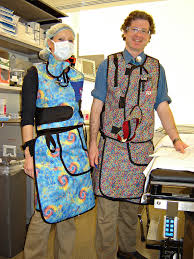Radiation Protection Clothes for X-ray Techs

Several types of radiation protection clothes are available to X-ray techs. The use of these garments protects radiologic technologists from exposure to scatter radiation. However, some imaging modalities are associated with a very low exposure to occupational radiation exposure. Radiologic technologists performing these examinations may not require special radiation protection clothes.
DXA operators can achieve adequate radiation protection by ensuring an appropriate distance from the patient. This can also be achieved with the addition of fixed/mobile lead screens. Therefore, lead aprons and other radiation protection clothes are not necessary while performing DXA scans. However, the work load in the center and the design of the DXA room should be taken into consideration. Some of the protective apparel available to radiation workers is discussed below.
Lead Aprons
Aprons are a type of radiation protection clothes designed to protect workers from ionizing radiation. A protective lead apron must be of a suitable weight. An apron that is too heavy can cause stress injury. An apron that is too thin may be ineffective. Thin lead is sometimes used in aprons to reduce the weight. Replacing the lead, either partially or completely, with other materials is another option. The material that replaces lead should have at least the same capacity to deflect scatter radiation. As of 2012, the standard is any material that is the equivalent of 0.5 millimeter thick lead.
Leaded Gloves
Another type of radiation protection clothes designed to protect the hands of workers is leaded gloves. These gloves reduce the radiation dose received by the hands by 15 to 30 percent as long as the hands are kept outside the primary beam. If the hands are placed in the way of the primary beam of X-rays, it can lead to an increase in kV triggered by the automatic exposure control (AEC) system. As a result, an increased radiation dose may be delivered to the patient as well as radiation workers in the room.
It should be noted that radiation personnel can often experience a false sense of security when they wear leaded gloves, which can lead them to unconsciously keep their hands in the path of the primary beam for an extended length of time. As a result, the protective capacity of the gloves is nullified. It is, therefore, critical to understand the importance of keeping the hands away from the primary beam, even when wearing protective leaded gloves.
Thyroid Shields and Eyeglasses
Other vital parts of the body, such as the eyes and thyroid gland, should be protected as well. Certain radiation protection clothes and devices can help achieve this. Many studies have concluded that the lens of the eye is highly sensitive to ionizing radiation. It is, therefore, advisable for individuals exposed to radiation to wear eyeglasses made of lead. In adults, thyroid shields must be worn at all times in compliance with the ALARA principle. It should be noted that the thyroid gland in an adult is significantly less sensitive to ionizing radiation than a child. However, childhood thyroid cancer does occur.
Storage of Radiation Protection Apparel

All radiation protection clothes, such as gloves, aprons, and thyroid collars, must be set flat and unfolded. Instructions in the manufacturer’s manual must be strictly practiced, including instructions for use and cleaning. It is also advisable to perform annual assessment of protective gear, both manually and visually. This ensures that the integrity of the lead is preserved. Suspected defects in the protective gear can be confirmed by fluoroscopic or radiographic inspection. Any rips or tears in a lead apron measuring more than 27 cm render the apron unusable. Equipment with small holes, cracks, or damage along the edges may also need to be rejected and disposed off depending on the size of the damage compared to the length and width of the apron.
Inspection of Radiation Protection Gear
It is noteworthy that manual or visual inspection does not reveal small defects in radiation protection clothes. An X-ray of the apron may be necessary to detect tiny cracks and tears along the sides. The outer layer of the apron should be carefully inspected. If there is an obvious thinning in this layer from prolonged use, then the apron should be discarded. Thinning can result in decreased apron weight and render it ineffective. The thickness and weight of the apron must be proportional to size; thus, measuring these parameters makes it possible to determine if the apron has become thin. The Velcro on the apron must also be checked. If the Velcro is irreparable, the apron cannot pass inspection because this could cause the apron to slide downward and expose the user to radiation.
Lead aprons are designed for a specific use. For instance, in a dental office, the apron is designed high around the neck to protect the thyroid gland. The disposal of lead aprons is similar to other hazardous materials. Because disposal of lead aprons can be cumbersome, companies like MetalQuest and Maguire & Strickland Refining have found ways to recycle old lead aprons. This is beneficial to the environment as well as medical facilities. Hospital may have the opportunity to sell or trade used aprons depending on state regulations.
New-Age Radiation Protection Materials
Radiation Shield Technologies has developed a radiation-blocking fabric called Demron. This material has the same protective capacity as lead shielding, but is a lightweight, non-toxic polymer that is very flexible. This makes it very useful for the production of radiation protection clothes. Demron can protect users from ionizing radiation by itself, and it can also be used as a shielding barrier for other biological and chemical hazards in combination with other protective materials. Because of its flexibility and versatility, Demron is more expensive than a standard lead apron and can cost four times more. However, Demron has additional advantages in that it can be maintained, cleaned, stored, and disposed like normal fabric. Demron material has been used in tactical vests and haz-mat suits.
X-ray CE Online
We offer a range of online courses for radiologic technologists who want to complete their ARRT® CE requirements. Browse through our range of e-courses available for purchase.
Get details about mammography continuing qualification requirements here
